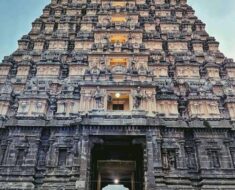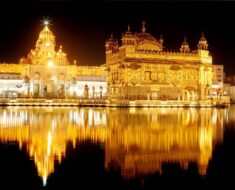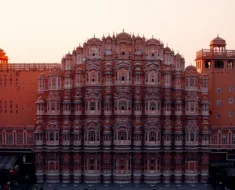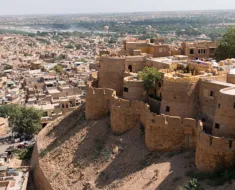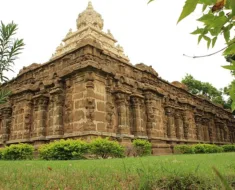The Chidambaram Nataraja Temple is one of the most famous ancient surviving temples in India. The Nataraja Temple is an active temple complex in South India that attracts thousands of devotees from all around the world.

The temple is located in the town of Chidambaram, Tamil Nadu. The name of the city Chidambaram literally means “stage of consciousness” and the temple is dedicated to Nataraja as the main deity – a form of Lord Shiva – as the lord of the dance.
The Chidambaram Nataraja Temple is also referred to as Thillai Nataraja Temple and is one the rarest temples in India since there is no iconic Lingam, which is worshipped. Lord Shiva is represented by an idol of Nataraja—Lord Shiva in a cosmic dancer position.
Religious Significance of the Temple
The Thillai Nataraja Temple is one of the Pancha Bhuta Sthalam temples. In Indian traditions, it is believed that the Universe comprises five cosmic elements—Earth, Water, Fire, Air, and Sky.
The Pancha Bhuta Sthalam temples are dedicated to Shiva and represent each one of these five elements. In Chidambaram Nataraja Temple which represents the sky and here Lord Shiva is worshipped as “Akasha Lingam” signifying that God is divine and beyond human comprehension.
The Pancha Bhuta Sthalam temples are:
- Kalahastheeshwara Temple represents the air – Srikalahasti, Andra Pradesh
- Ekambareshwarar Temple represents the earth – Kanchipuram, Tamil Nadu
- Jambukeshwarar Temple represents the water – Thiruvanaikaval, Trichy, Tamil Nadu
- Arunachaleshwarar Temple represents the air – Thiruvannamalai, Tamil Nadu
- Thillai Nataraja Temple represents the sky – Chidambaram, Tamil Nadu
💡 Read More: 12 Jyotirlinga Temples in India – Shrines of Shiva
Legends about the Nataraja Temple
The legend of the Chidambaram Nataraja Temple states that a group of saints in the Thillai forests believed that God could be controlled by rituals and mantras.

To break their arrogance Lord Shiva visits them in the forest in the form of a dancer mendicant (Bhikshatana) accompanied by Lord Vishnu as Mohini, his wife. On seeing them the sages and their wives are enchanted by their beauty.
On seeing their wives enchanted, the sages became enraged and invoked scores of ‘serpents’, but Lord Shiva donned the serpents as ornaments around his neck and waist. The sages then further invoked a fierce tiger, which the Lord skinned and donned as a shawl around his waist.
Completely frustrated, the sages gathered all their spiritual strength and invoked a powerful demon named Muyalakan – a symbol of complete arrogance and ignorance. Lord Shiva then stepped on the demon’s back and performed the Ananda Thaandava (the cosmic dance), thus disclosing his true form. This made the sages realize that this Lord is the truth and is therefore beyond all mantras and rituals.
💡 Travel Tips: 10 Famous Ancient Temples in Tamil Nadu – Religious Places
History
The present surviving temple structure traces back to the Chola dynasty during the 10th century. Shiva Nataraja was the family deity of the Cholas and Chidambaram used to be their capital at that time.
The earliest mention of the “dancing god of Chidambaram” as Shiva is found in 6th and early 7th-century texts by Appar and Sambadar
The temple has a history of several damages and renovations by different dynasties, with Viduvelvidugu Perumthachan being the chief architect for its restoration.
Most of the current structures and plans in the Chidambaram temple complex, including the mandapas and their pillar carvings, the various shrines, the sacred water pool, and the gopurams are from the 12th and 13th centuries, attributed to the late Chola and early Pandya kings.
Cholas, Pandyas, Vijayanagara kings, Cheras, and Pallavas made significant contributions to the temple during the ancient and pre-medieval periods.
Architecture
The Nataraja Temple complex is spread over an area of 40 acres. The architecture of the temple is based on the Dravidian style of architecture.
The temple complex is designed with five concentric courtyards or Prakaramas with each prakarama representing five cosmic elements. The inner Prakarama is not visible to the devotees only the remaining four are accessible to the public.
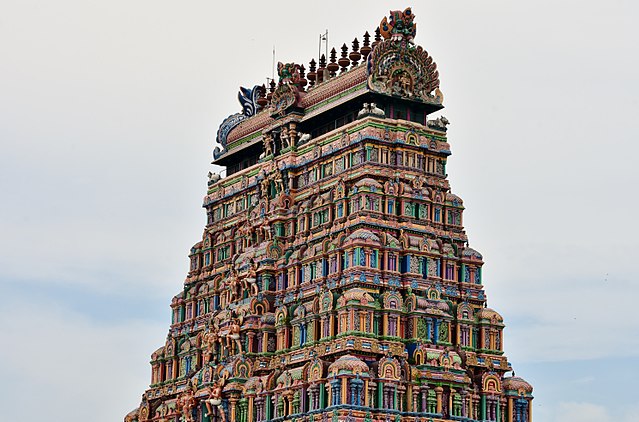
The temple has nine gopuram gateways connecting the various courtyards and five main halls or sabhas – Chit Sabha, Kanaka Sabha, Deva Sabha, Nritya Sabha, and Raja Sabha.
- Chit Sabha houses the prime idol of Lord Nataraja.
- Kanaka Sabha is used for performing daily rituals.
- Nrithya Sabha where the Lord Shiva is said to have danced with Goddess Kali – an embodiment energy and established His supremacy.
- Raja Sabha or the 1000-pillared hall which symbolizes the yogic chakra of the pillared lotus or Sahasraram
- Deva Sabha houses the Pancha moorthis and a revered collection of historic bronze sculptures and modern-era frescoes.
Read More: Oldest Temple in Temple – Mundeshwari Devi Temple
There are 28 pillars holding the sanctum sanctorum representing the 28 methodologies for the worshipping of Lord Shiva.
The wall carvings of Chidambaram Nataraja Temple display all the 108 karanas from the Natya Shastra by Bharata Muni, and these postures form a foundation of Bharatanatyam an Indian classical dance
Vyagrapada and Patanjali, the revered saints have their images embossed on the doors of Chit Sabha, thus serving as guards to the sanctum sanctorum. These saints are believed to have witnessed the cosmic dance of eternal bliss by Lord Shiva.
Temple Timings
Morning 6.00.a.m to 12.00 noon
Evening 5.00.p.m. to 10.00 night
How to Reach Chidambaram Nataraja Temple
By Air
The nearest airports to Chidambaram are Tiruchirappalli (195 Km) & Chennai (225 km) and Chidambaram is, well connected by train and bus routes from these places. You can easily hire a private taxi or cab.
By Train
Chidambaram is well connected by rail to the temple towns of Rameswaram, Thanjavur, and Kumbakonam and other cities of Tamil Nadu
By Road
Frequent buses are available from various places in Tamil Nadu, Andhra, and Karnataka to Chidambaram. The best way to reach Chidambaram from Chennai is via Pondicherry (East Coast Road). It takes 4-5 hours by car to reach Chidambaram from Chennai.
Read More: 22 Incredible Ancient Temples In India
Some Interesting Facts about the Chidambaram Nataraja Temple
- The Kanaka Sabha has a gold-plated roof. The temple’s roof is formed of 21,600 gold sheets depicting 21,600 breaths (15 x 60 x 24 = 21600) taken by a person in a single day.
- It is fixed with 72,000 golden nails representing the 72,000 visible and invisible nerves present in the human body.
- Nataraja temple has 9 gateways which signify the 9 holes/ openings present in the human body.
- Chidambara Rahasyam (Secret of Chidambaram) is a Hindu belief that there is a secret message conveyed through the embossed figure near the shrine of Shiva in Chidambaram temple.
- Chidambara Rahasyam is hidden by a curtain, which is only opened by priests for special occasions. The fortunate devotees who have a glance at the Chidambara Ragasiyam can hardly see golden Bilva leaves signifying the presence of Lord Shiva and Goddess Parvati there.
- The Chidambaram temple car is the most beautiful example of a temple car in all of Tamil Nadu. Lord Nataraja descends twice a year on this car and is drawn by several thousand devotees during the festivals.




